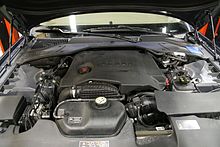|
Ford AJD-V6/PSA DT17
The AJD is a family of V6 and V8 turbodiesel engines with a clean-sheet architecture and variable valve timing developed by Ford of Europe for its then-subsidiaries Jaguar and Land Rover, as well as for its partner PSA Group working under the Gemini joint development and production agreement. It is called the AJD-V6 in the Jaguar and Land Rover vehicles and the DT17/DT20 by Citroën and Peugeot. The engines share the same bore/stroke ratio, with the V6 version displacing 2.7 L (2,720 cc) and the V8 version displacing 3.6 L (3,630 cc). The V6 and the V8 were launched in 2004 and 2006 respectively. The V6 engine meets the Euro IV emissions standards. A DT20 3.0 L (2,993 cc) was added in 2009 and is based on the DT17 2.7 L (2,720 cc). The V6 is used across many vehicles, from the Citroën C5 and C6, to the Land Rover Discovery, Range Rover, multiple cars in the Jaguar range, and also the Ford Territory and next gen Ford Ranger. Common constructionThe engine family utilises twin overhead camshafts and multi-valves, single or twin-turbochargers with an air-to-air intercooler, and innovative compacted graphite iron (CGI) block construction that leads to a low weight of 202 kg (445 lb) dry. Fuel supply is high-pressure common rail direct injection. Lion V6 To improve the engine's low-speed torque range for off-roading and towing applications, the Land Rover variant utilised a large capacity single-turbocharger, rather than use the twin-turbo design; in addition the engine is fitted with a large engine driven cooling fan to support low speed, high load driving as may be encountered in desert conditions. Furthermore, the Land Rover variant of the Lion V6 includes a deeper, high capacity sump with improved baffles to maintain oil pressure at off-roading extreme angles and multi-layered seals to keep dust, mud and water at bay and different transmission bell housing bolt pattern. The Lion V6 – constructed from compacted graphite iron[1] – is a member of the Ford Duratorq family and is produced at Ford's Dagenham engine plant; 35,000 engines were produced from April to December 2004. The 3.0-litre design, known as the Gen III, superseded the 2.7-litre, and uses turbochargers on a series-sequential system and has an uprated common rail injection system incorporating fuel injectors with piezo crystals fitted nearer to the tip to reduce engine noise and a metering mode to reduce oversupplying fuel, decreasing fuel consumption and unused fuel temperature over the 2.7-litre model. The sequential turbocharger system utilizes the smaller of the two turbos when the engine is running at low revolutions; once the engine has reached 2,800 rpm, the larger turbocharger is also used to pressurize the intake. Jaguar tested fitting the engine to its XK model but didn't carry the project over to production. The 3.0-litre variants used by Land Rover feature the 2.7-litre's off-roading adaptations plus calibration of the engine's electronics to allow the use of low-quality fuels. 2.7HDi/TDV6/2.7TD
60-degree V6 engine, single- and twin-turbo diesel, 2,720 cc (2.7 L; 166.0 cu in), bore x stroke 81 mm × 88 mm (3.19 in × 3.46 in), compression ratio 17.3:1
Compacted graphite iron cross bolted block
High strength aluminium, DOHC with four valves per cylinder
Single turbocharger or twin-turbochargers with air-to-air intercooler, electronically actuated variable geometry with transient over-boost capability, port deactivation system
Siemens Common rail (CR) direct diesel injection, maximum injection pressure of 1,650 bars (23,900 psi), piezo injectors
3.0HDi/TDV6/SDV6
60-degree V6 engine, twin-turbo diesel, 2,993 cc (3.0 L; 182.6 cu in), bore x stroke 84 mm × 90 mm (3.31 in × 3.54 in), compression ratio 16.4:1
Compacted graphite iron cross bolted block
High strength aluminium, DOHC with 4 valves per cylinder
Twin-turbochargers with air-to-air intercooler, electronically actuated variable geometry with transient over-boost capability, port deactivation system
Bosch Common rail (CR) direct diesel injection, utilising a Bosch EDC17CP11 engine management control unit and maximum injection pressure of 2,000 bars (29,000 psi), piezo injectors
Lion V8Built at Ford's Dagenham engine plant in Essex, the 3.6-litre V8 twin-turbo diesel engine began production in April 2006. The 4.4 L variant is built in Ford's Chihuahua Engine plant in Mexico. Much speculation in the United States has focused on this engine as a possible Diesel entrant in the F-150 pickup truck and Expedition SUV.[2] It was announced that the new F-150 engine was to be based on this engine and enlarged to 4.4 L, but that program was later cancelled. The Cleveland Engine plant recently began small-scale production of the exotic compacted graphite iron (CGI) used in the block's construction, leading many to expect production of the engine there. Ultimately, Ford went with the 3.0 L Lion V6 modified for US truck use, utilising a single turbocharger. 3.6 TDV8
90-degree V8 engine, twin-turbo diesel, 3,630 cc (3.6 L; 221.5 cu in), bore x stroke 81 mm × 88 mm (3.19 in × 3.46 in), compression ratio 17.3:1
Compacted graphite iron cross bolted block
High strength aluminium, DOHC with 4 valves per cylinder
Twin-turbochargers with air-to-air intercooler, electronically actuated variable geometry with transient over-boost capability, maximum boost pressure of 1.6 bars (23 psi), piezo injectors
See alsoNotes
References
External links
|
||||||||||||||||||||||||||||||||||||||||||||||||||||
Portal di Ensiklopedia Dunia
